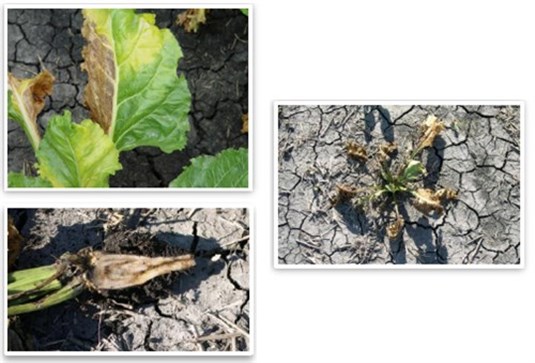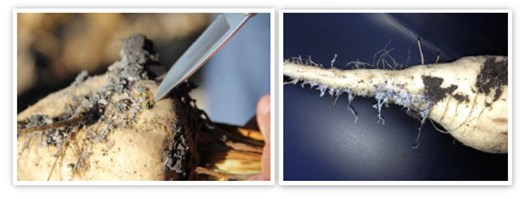583 - Variety Selection: Challenges And Opportunities
Getting variety selection right on a field-by-field basis becomes more challenging every year. Spread of Fusarium into new piler districts, increased incidence and severity of root aphids and presence of multiple diseases in a single field are just a few of the challenges. Selecting for disease resistance and matching it to high revenue per ton and per acre requires careful study of variety performance data. Positioning a variety with the right characteristics in each field greatly enhances the opportunity to maximize beet crop revenue. Keep in mind that the only control option for root aphids is variety selection. Liming provides good control of Aphanomyces (UM research) and minimal control of Fusarium (NDSU research). Seed treatment, in-furrow, T-band and POST fungicide use all help manage Rhizoctonia.
Fusarium Symptoms

Variety Selection Criteria
- Revenue per acre
- Revenue per ton
- Revenue per ton versus hauling cost
- Disease resistance for each field
- Vigor and emergence characteristics
- Seed treatment options
- Harvestability
The Seed Treatment Dilemma
Numerous seed sizing, priming, insecticide and fungicide options are available. These options should be complementary to variety selection options. The following questions must be thought about and answered in regard to how they impact other agronomic practices used.
Q1. Which fungicide treatment is critical to disease management problems on my farm?
Q2. Will in-furrow, T-band or post fungicide applications better control my disease problem than seed treatments?
Q3. Will seed treatment choice allow continued use of starter fertilizer without stand loss concern?
Q4. Will seed treatment insecticide choices be better than at - plant granule or POST applied insecticides for insect problems in each field?
Q5. How will new or pending registration of seed treatment fungicides affect my resistant variety choices for 2014?
Headline Application Is a MustRegardless of Cercospora severity American Crystal Sugar Company strongly recommends applying Headline in late August or very early September. Keep your canopy healthy and harvest and deliver better storing beets. Note: Tank mix with another fungicide if you have Headline resistance in your area. |
Root Aphids Back Again in 2013
Rarely has the sugarbeet root aphid caused economic losses to the sugarbeet crop in the Red River Valley. Very isolated incidences of root aphids have been observed infrequently for several decades. However incidence and severity increased greatly in 2012, especially in the mid Red River Valley. Root aphid incidence was observed in late July and early August 2013. Severe economic losses occurred in some fields in 2012. Root aphid damaged beets had very severe sucrose losses in storage in USDA studies in 2012.
The insects are favored by hot weather, low rainfall and depleted soil moisture conditions. The only effective means of control of economic losses is variety resistance. Seed suppliers can recommend resistant varieties for selection. Check your fields now.

Bolter Control
Must be completed for the final time by September 15, 2013.
Nitrogen Management Program
Consider zone soil testing for 2013. Splitting N applications between fall and spring and sidedressing applications will increase likelihood of maximizing yield and quality for the 2014 crop.
